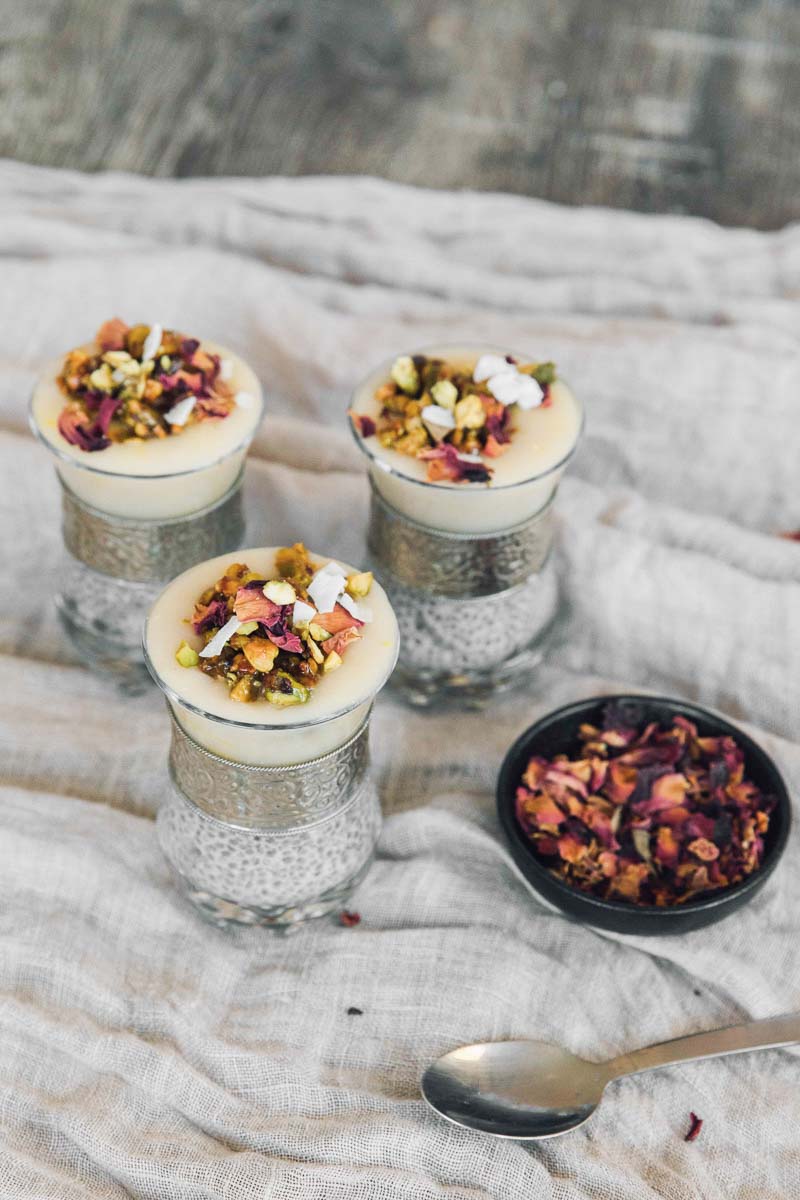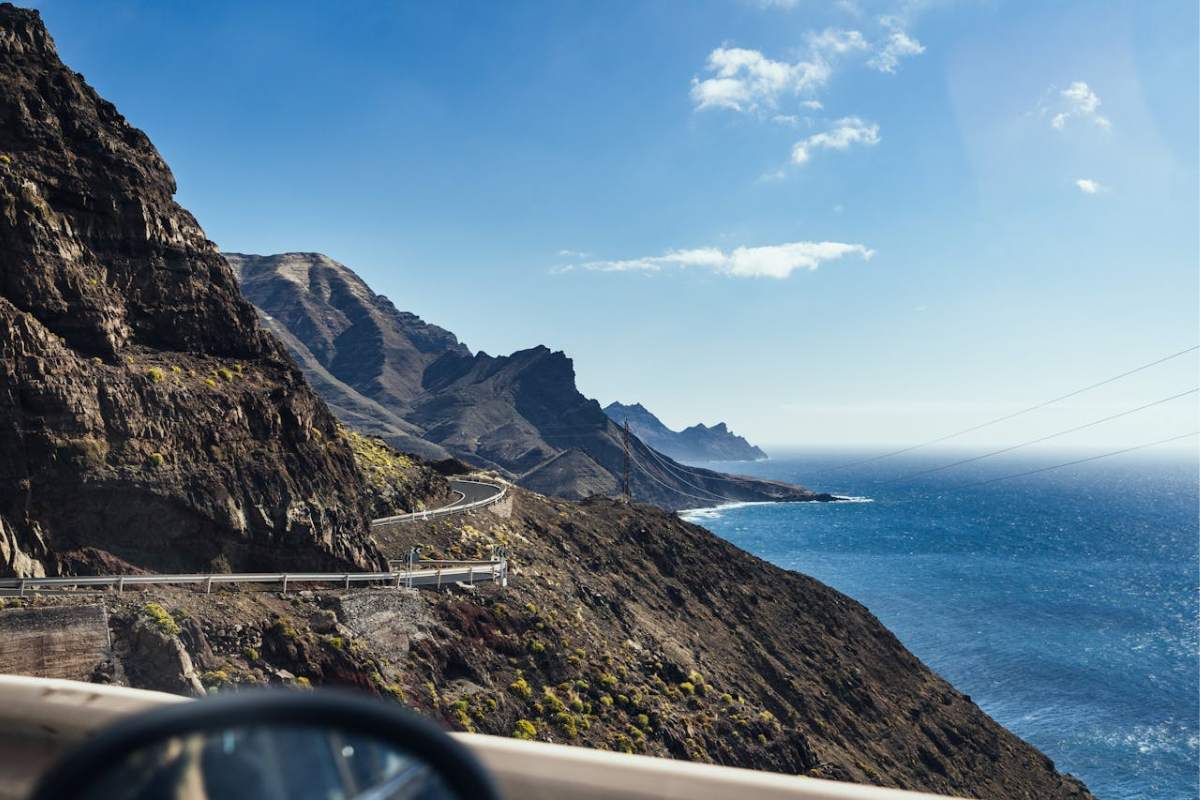Inspired by a dessert from Bahrain, mahalabia and chia pudding are layered together and topped with a caramelized pistachio crumble in this unique recipe. It’s dairy-free, refined-sugar free and healthy enough to have for breakfast!

Overview of Bahrain
At the start of each week, we spend lots of time researching cuisines and planning out which recipes we are going to make. It is as equally nerve-racking as it is thrilling when cuisines pop up of which we have absolutely no prior knowledge. Bahrain was one of those cuisines.
Bahrain is the fourth Middle Eastern country that has pop up since the beginning of this cooking challenge. We have always cooked a lot of Middle Eastern food in our house. In fact, it’s rare for a week to go by without an Ottolenghi cookbook being opened for inspiration. However, due to my lack of regional knowledge, I’ve mostly viewed Middle Eastern cuisine in the broad sense of the term. Now, it was time to learn the ins and outs of Bahraini cuisine!

History of Bahraini Cuisine
Bahrain is a small island state near the Persian Gulf. Since ancient times, Bahrain has been a key sea port and trading junction. This has meant its cuisine has had many influences, including Arabic, Persian, Indian and European.
Due to its position in the Gulf, seafood is abundant in Bahrain and features in many of their traditional dishes. Most typically, a Bahraini meal will consist of fish or meat served with a variation of rice. However, thanks to a large ex-pat community, you can find plenty of vegetarian food around Bahrain. A strong Arabic influence has made hummus and falafel particularly popular options. As for local Bahraini vegetarian food, the options are a little more limited.
Popular Bahrain Desserts
- Mulhammar- Sweet rice cooked with rosewater, saffron, sugar, and ghee, typically served with a main meal
- Halwa Bahraini- A very sweet dessert with a gel-like texture. Whilst in other places Hawla is commonly made with semolina or flour, in Bahrain it is uniquely made from corn starch and rapeseed oil.
- Mahalabiya- A pudding made with milk, rice flour and sugar which is flavoured with rose or orange blossom water.
- Maamoul– Date-filled cookies popular across the Middle East.
- Umm Ali– A combination of pastry dough, milk, sugar, nuts, and raisins that is typically consumed warm.

Making this mahalabia recipe
While researching Bahraini cuisine, I was surprised to come across two dishes that had a very similar flavour profile and contained many of the same ingredients. Obviously, this is not an abnormal occurrence in itself. The surprising part was that one of the dishes is served as a main dish and the other a dessert.
Both Mulhammar and Mahalabia are flavoured with sugar, saffron, rosewater. However, Mulhammar is made of basmati rice and served as a main dish, whilst Mahalabia is made with rice flour and served as a pudding. Thinking that we’d rather not waste our daily sugar intake on dinner, we opted to make the latter.
Typically, Mahalabia (also spelt Mahalabiya, Muhalabiya, Muhallebi… even after a lot of research I’m still aren’t sure of the correct Bahraini spelling) is made with rice flour, whole milk or cream and lots of sugar. Similar to when we turned Angolan coconut pudding into a porridge, we wanted to make a lighter, breakfast-friendly version of this Bahraini rice pudding. However, we also wanted to stay as true as we could to the texture and flavour profile of the original.

A healthy take on a Mahalabia recipe
As such, we decided to integrate Mahalabia into a layered chia pudding, inspired by this recipe we found. We’ve always enjoyed integrating Middle Eastern flavours into our morning concoctions. We often include ingredients such as dates, honey, pistachios and rose water in smoothies, porridge, overnight oats and chia pudding. However, this layered chia pudding was at another level. It was by far the most unique and fragrant breakfast creation we’ve made to date.
For this recipe, we used chia pudding for the base, rice pudding (Mahalabia) for the middle layer, and a caramelized pistachio crumble for the top. To stay true to a Bahraini flavour profile, we infused the pudding with rosewater, orange blossom water, cardamom and saffron (more on that later). Then, to make the pudding a little healthier, we used coconut milk instead of whole milk, and sweetened it with honey instead of refined sugar.
How to make this mahalabia recipe
1. Make chia pudding layer– by combining all the ingredients in a bowl and refrigerate overnight.

2. Make mahalabia layer– In a bowl, mix 1/2 cup coconut milk with rice flour until paste forms. Meanwhile, pour coconut milk, honey, cardamon pods and saffron threads in a saucepan over medium heat. Once mixture comes to a boil, take off heat and stir in rice flour paste. Allow to cool, then chill in the fridge for at least 30 minutes (or overnight if you do at the same time as the chia pudding)

3. Make pistachio crumble– Melt coconut oil in a frying pan over medium heat. Add chopped pistachios and honey, tossing so nuts are coated in coconut oil and honey. Cook in pan for five minutes or until caramelized, occasionally stirring.
4. To serve: In 3 glasses, divide up chia pudding, followed by coconut milk pudding and topped with pistachio crumble.

Ingredients for mahalabia chia pudding
- Rosewater/ orange blossom water: You will most likely need to go to a specialty store to find rose water and orange blossom water. These two ingredients come up a lot in Middle Eastern cuisine and impart such unique flavour to dishes. You can skip one or the other but we’d recommend both if you want to experience this pudding in its full fragrant glory!
- Saffron: Saffron is another great ingredient to have on hand when cooking Middle Eastern cuisine. However, as mentioned above, it is a very expensive spice to invest in, so free to skip it out of the recipe if you don’t have any.
- Honey: We used honey in this recipe as we felt the floral notes worked really well in the pudding. However, feel free to substitute for any other sweetener such as maple syrup, rice bran syrup or agave.
- Rice flour: If you don’t have rice flour on hand, you can substitute this for arrowroot or corn starch.

Serving suggestions for the layered chia pudding
If you want to keep things simple, you could choose to make this recipe with either just the chia pudding or rice pudding, instead of a layer of each. If you do this, I’d still highly recommend topping it with pistachio crumble as it adds such a nice texture to the dish.
More breakfast ideas to try
- Caramelised Banana Porridge from Benin
- Cocada Amarela Recipe: Spiced Coconut Porridge from Angola
- Torrejas Recipe: Cinnamon French Toast from Andorra
Liked this mahalabia recipe? Pin it for later!







